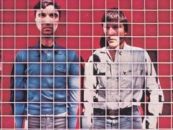 The final studio project by The Beatles, Abbey Road—issued before but recorded mostly after Let It Be—opens with a John Lennon song called “Come Together.” In fact, though, the group was coming apart. Six days before the album’s Sept. 26, 1969, U.K. release, Lennon privately told his bandmates he was leaving, and Paul McCartney publicly quit the foursome less than seven months later. While making the LP, they were rarely all in the studio at the same time. When they were, tensions reportedly ran high.
The final studio project by The Beatles, Abbey Road—issued before but recorded mostly after Let It Be—opens with a John Lennon song called “Come Together.” In fact, though, the group was coming apart. Six days before the album’s Sept. 26, 1969, U.K. release, Lennon privately told his bandmates he was leaving, and Paul McCartney publicly quit the foursome less than seven months later. While making the LP, they were rarely all in the studio at the same time. When they were, tensions reportedly ran high.
The album doesn’t even hint at the discord. Under the watchful eye of producer George Martin, the Beatles managed to deliver a memorable last hurrah that contains more than a few classics and wound up topping the charts in the U.S. and U.K. for 11 and 17 weeks, respectively. It has sold more than 30 million copies and become the group’s bestselling studio LP. Even its cover image, which shows the Beatles crossing Abbey Road outside EMI’s London recording studios, is iconic.
Listen to take 5 of “Come Together”
Related: The 11 #1 albums of 1969
The material on side one of the original vinyl release would alone probably have been enough to make it a hit. In addition to Lennon’s funky, aforementioned “Come Together,” which was a chart-topping single, it includes one of George Harrison’s best songs up to that point, the sublime “Something,” which made it to #1 as well. Also on the menu: McCartney’s “Oh! Darling,” a well-delivered 1950s-style ballad; and his mischievous “Maxwell’s Silver Hammer,” which juxtaposes bouncy, vaudevillian music with lyrics about a boy who kills multiple people. Ringo contributes the fanciful “Octopus’s Garden”; and Lennon offers the intense, nearly eight-minute “I Want You (She’s So Heavy),” his ode to Yoko Ono.
Side two begins with Harrison’s other contribution to the album, “Here Comes the Sun,” which offered further evidence that this late bloomer might be capable of just as much greatness as Lennon and McCartney.
(Still more evidence arrived a year later when Harrison released All Things Must Pass, one of the best albums ever by an ex-Beatle.)
Watch a video of “Here Comes the Sun,” with the new mix
Lennon’s beautiful ballad “Because” follows, after which comes a 17-minute rock symphony that seamlessly stitches together eight lyrically unrelated and musically disparate tunes. Among them: Paul’s “You Never Give Me Your Money,” “She Came In Through the Bathroom Window,” “Golden Slumbers,” “Carry That Weight” and “The End,” and John’s “Sun King,” “Mean Mr. Mustard,” and “Polythene Pam.” A long silence follows, after which the side ends with a “hidden” 25-second bonus track, Paul’s lilting, acoustic “Her Majesty.”

The Beatles, Twickenham Film Studios, April 9, 1969 (Photo: Bruce McBroom © Apple Corps Ltd.; used with permission)
As good as most of Abbey Road is, you could argue that it isn’t even among the Beatles’ five best records: Rubber Soul, Revolver, Sgt. Pepper, Magical Mystery Tour and the White Album all provide stiff competition. But those albums set an incredibly high bar. Compared with the work of just about any other contemporary group, Abbey Road was—and remains—a triumph. And it’s even better on 2019’s 50th anniversary edition produced by Giles Martin, son of the Beatles’ original producer, who also oversaw first-rate anniversary editions of Sgt. Pepper and the White Album.
This anthology offers three compelling reasons to buy it.
First, it delivers sound quality that demonstrates how much technology has advanced over half a century. True, the original album—the first Beatles LP to be recorded on eight-track tape—delivers excellent audio, and you’ll hear only subtle improvements to that on Martin and engineer Sam Okell’s new mix on the first CD here. But you don’t have to be an audiophile to be blown away by the DTS-HD Master surround-sound version of the album on the set’s Blu-ray audio disc (which also includes hi-res stereo and Dolby Atmos versions).

Ringo Starr, George Harrison and John Lennon inside of Abbey Road Studios, 1969 (from the Beatles’ website)
Two CDs containing a total of 23 demos, outtakes and oddities offer a second carrot for record buyers. No, there’s not nearly as much previously unreleased material as you’ll find on the White Album’s anniversary edition; and a few of the alternate readings here aren’t all that different from the familiar ones. But for Beatlemaniacs, there’s lots to savor, such as McCartney’s demos of his “Come and Get It” and the lovely “Goodbye,” which yielded 1969 hits for Badfinger and Mary Hopkin, respectively; a solo reading by Harrison of “Something”; and substantially altered renditions of “Mean Mr. Mustard,” “She Came In Through the Bathroom Window” and “I Want You (She’s So Heavy),” the latter featuring a long organ coda by Billy Preston.
Listen to Paul McCartney’s demo of “Goodbye,” later a hit for Mary Hopkin
Also here are alternate takes of “Old Brown Shoe” and “The Ballad of John and Yoko,” songs that were released together as a 1969 single.
Listen to Paul McCartney’s demo of “Come and Get It”
Granted, most of the alternate versions fall short of the recordings the group ultimately released. Still, if you’ve been listening to those recordings for decades, you’ll likely find the differences fascinating. The alternate renditions will also remind you of just how much preparation it can take to sound spontaneous. The set includes, for example, take 27 of “Polythene Pam” (which begins with McCartney advising his bandmates to go easy on the intro and not “give away all your best bits” at the beginning). Also here: take 36 of “You Never Give Me Your Money” and take 39 of “Something.” Clearly, these guys were as obsessed with getting it right as ever.
Listen to take 36 of “You Never Give Me Your Money”
Speaking of getting it right, the anniversary set’s third major attraction, its 100-page, LP-sized hardcover book, does just that. The well-illustrated volume opens with a foreword by McCartney, who recalls the group’s first arrival in what is now known as Abbey Road Studios and compliments his bandmates’ material, including Lennon’s “Because” (“achingly elegant”) and Harrison’s tracks (“two of the most beautiful songs he had ever written”).
Then comes an introduction from Giles Martin, who notes that the magic is in the music and “our quest is simply to ensure everything sounds as fresh and hits you as hard as it would have on the day it was recorded.”
Another essay, “The Arrival of Abbey Road”—one of four articles by British journalist and BBC producer Kevin Howlett—reminds us that not everyone applauded the album when it first appeared. Some critics raved, but the New York Times’ Nik Cohn, for example, liked only the side-two medley and pronounced the rest of the album an “unmitigated disaster.” Lennon himself, meanwhile, called that medley “junk” and indicated that he hated “Maxwell’s Silver Hammer.”
Also in the book, which includes photos of handwritten lyric sheets: a long essay that puts the Abbey Road project in context; a detailed track-by-track commentary that includes session dates, locations and credits; an article about the album cover (accompanied by outtakes from the photo session); and a piece by British music journalist David Hepworth, who concludes, “The story of the Beatles is the best story in pop. Abbey Road is the ending that story deserved.”
True—and this boxed set is the anniversary treatment that that album deserved. The 2019 50th anniversary editions are available in the U.S. here and in the U.K. here.







1 Comment so far
Jump into a conversationTo me Magical Mystery Tour has never been an album. Here in Europe it was originally released as a double EP and i have always considered it as that. To me five best Beatles LP’s are Sgt. Pepper, White Album, Abbey Road, Revolver and Rubber Soul.